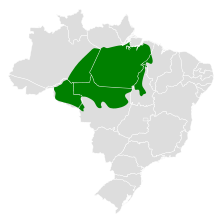| Para gnatcatcher | |
|---|---|
| Scientific classification | |
| Domain: | Eukaryota |
| Kingdom: | Animalia |
| Phylum: | Chordata |
| Class: | Aves |
| Order: | Passeriformes |
| Family: | Polioptilidae |
| Genus: | Polioptila |
| Species: | P. paraensis
|
| Binomial name | |
| Polioptila paraensis Todd, 1937
| |

| |
The Para gnatcatcher (Polioptila paraensis) or Klages's gnatcatcher, is a species of bird in the family Polioptilidae. It is endemic to Brazil.[1]
YouTube Encyclopedic
-
1/3Views:427528 9063 711
-
The Blue-Gray Gnatcatcher: Facts
-
How To Get Rid of Gnats!!! Inside The House...
-
David Sibley: The Sibley Guide To Birds, 2nd Edition
Transcription
Taxonomy and systematics
The Para gnatcatcher is monotypic It was formerly treated as a subspecies of the Guianan gnatcatcher (Polioptila guianensis) but since mid-2019 has been considered a separate species based on differences in morphology and vocalization.[2][3][4]
Description
The Para gnatcatcher is 10 to 11 cm (3.9 to 4.3 in) long and weighs approximately 6 g (0.21 oz). The male's head, back, and breast are mouse gray and the rest of its underparts white. There is minimal contrast between the throat, breast, and belly. The innermost feathers of its tail are black and the outermost white, with those between intergrading. The female is similar but has a paler face.[5]
Distribution and habitat
The Para gnatcatcher is found only in Brazil, in a broad band south of the Amazon River from its mouth southwest almost to northern Bolivia. It inhabits the borders and canopy of humid primary forest, mostly below 500 m (1,600 ft) elevation.[5]
Behavior
Feeding
The Para gnatcatcher's diet is little known but is assumed to be arthropods like that of other Polioptila gnatcatchers. It actively forages in the canopy and sub-canopy.[5]
Breeding
The Para gnatcatcher's breeding phenology has not been documented.[5]
Vocalization
The Para gnatcatcher's song is "repeated high...notes, evenly delivered" [1].[5]
Status
The IUCN has not assessed the Para gnatcatcher. "Of the ecoregions occupied by this species, only one (Tocantins/Pindare moist forest) is considered to be at serious risk."[5]
References
- ^ Gill, F.; Donsker, D.; Rasmussen, P. (January 2021). "IOC World Bird List (v 11.1)". Retrieved January 14, 2021.
- ^ Whitney, B.M.; Alonso, J.A. (2005). "A new species of gnatcatcher from white-sand forests of northern Amazonian Peru with revision of the Polioptila guianensis complex". Wilson Bulletin. 117 (2): 113–127. doi:10.1676/04-064.
- ^ Remsen, J. V., Jr., J. I. Areta, E. Bonaccorso, S. Claramunt, A. Jaramillo, D. F. Lane, J. F. Pacheco, M. B. Robbins, F. G. Stiles, and K. J. Zimmer. Version 23 May 2021. A classification of the bird species of South America. American Ornithological Society. https://www.museum.lsu.edu/~Remsen/SACCBaseline.htm retrieved May 24, 2021
- ^ Gill, F.; Donsker, D. (June 2019). "IOC World Bird List (v 9.2)". Retrieved June 22, 2019.
- ^ a b c d e f Atwood, J. L., S. B. Lerman, G. M. Kirwan, and H. F. Greeney (2020). Klage's Gnatcatcher (Polioptila paraensis), version 1.0. In Birds of the World (S. M. Billerman, B. K. Keeney, P. G. Rodewald, and T. S. Schulenberg, Editors). Cornell Lab of Ornithology, Ithaca, NY, USA. https://doi.org/10.2173/bow.guigna4.01 retrieved May 29, 2021
